捷达轿车GIF两轴式变速器的设计
课程设计(二轴五档变速器 )

目录1方案的选择 (1)1.1设计任务书 (1)1.2总体方案论证 (1)1.3零部件结构方案分析 (2)1.3.1齿轮形式 (2)1.3.2换挡机构形式 (2)1.3.3变速器轴承 (2)2变速器主要参数的选择 (2)2.1传动比范围的选择 (2)2.2.1功率转速 (2)2.2.2主减速器传动比的初选 (3)2.2.3最小传动比的选择 (4)2.2.4最大传动比的选择 (4)2.2挡数 (5)2.3分配各挡传动比 (5)2.4传动路线图 (6)3变速器参数的计算与校核 (6)3.1初定中心距 (6)3.2初定齿轮参数(斜齿轮齿形参数) (7)3.2.1模数 (7)3.2.2压力角 (8)3.2.3齿宽 (8)3.2.4螺旋角 (9)3.2.5齿顶高系数与顶隙系数 (10)3.3分配各挡齿数 (10)3.3.1确定一挡齿轮的齿数 (11)3.3.2对中心距及一挡齿轮螺旋角进行修正 (11)3.3.3确定二挡齿轮的齿数 (12)3.3.4确定三挡齿轮的齿数 (12)3.3.5确定四挡齿轮的齿数 (12)3.3.6确定五挡齿轮的齿数 (13)3.3.7确定倒挡齿轮的齿数 (13)3.3.8变位系数 (13)3.4齿轮的校核 (16)3.4.1齿轮的损坏形式 (16)3.4.2齿轮的强度计算 (16)3.4.3齿轮的材料 (21)3.5轴的设计与校核 (21)3.5.1初选轴的直径 (21)3.5.2轴的可靠性分析 (21)3.6轴承的计算与校核 (27)3.6.1轴承形式的选择 (27)3.6.2轴承尺寸的选择 (27)3.6.3轴承寿命的计算 (29)4设计参数汇总(优化后) (34)4.1汽车主要参数 (34)4.2变速器主要设计参数 (34)参考文献 (37)1方案的选择1.1设计任务书根据给定的汽车性能参数,进行汽车变速箱传动方案设计,计算各部件的设计参数,绘出指定总成的装配图和部分零件图表1-1 乘用车传动系统的主要参数1.2总体方案论证变速器用来改变发动机传到驱动轮上的转矩和转速,目的是在原地起步、爬坡、转弯、加速等各种形式工况下,使汽车获得不同的牵引力和速度,同时使发动机在最有利的工况范围内工作。
捷达五档手动变速器动力传递路线
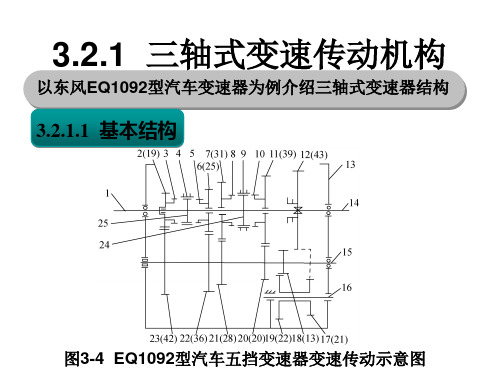
倒挡传动比为
3.2.2 发动机前置横向布置的两 轴式变速传动机构
学习目的与要求
1.掌握变速器结构 2.熟悉各档动力传动路线 3.能计算各档的传动比
图3-16 捷达王轿车五挡变速器结构图
倒档
5档
4档 3档 2档
1档
1档
1、2档结 合套右移
2档
1、2档结 合套左移
3档
3、4档结 合套右移
4档
3、4档结 合套左移
5档
5档结合套 右移
倒档中间 轴齿轮
倒档
倒档
z4 38 z16 32
z6 11 z18 35 z7 12 z191 11
z12 40
z15 34
5档
4档 3档 2档
1档
z17 37
z4 38 i1 3.455 z6 11 z18 35 i2 1.944 z8 18 z17 37 i3 1.370 z9 27 z16 32 捷达王轿车五挡变速器各 i4 1.032 z11 11 挡传动比依次为 z15 34 i5 0.850 z12 40 z19 zR z19 38 iR 3.167 z R z7 z7 12
z23 z11 42 39 4.31 z2 z20 19 20
i2
i3
z23 z7 42 31 2.45 z2 z21 19 28
四挡传动比为
五挡传动比为
i4
z23 z6 42 25 1.54 z2 z22 19 36
i5 1
iR z23 z19 z12 42 22 43 7.66 z2 z18 z17 19 13 21
车辆工程毕业设计92捷达轿车六档手动变速器设计

第1章绪论1.1 课题的目的和意义变速器用来改变发动机传到驱动轮上的转矩和转速,目的是在原地起步、爬坡、转弯、加速等各种行驶工况下,使汽车获得不同的牵引力和速度,同时使发动机在最有利的工况范围内工作[1]。
中间轴式变速器多用于发动机前置后轮驱动汽车和发动机后置后轮驱动的客车上。
变速器若采用浮动式结构的齿轮轴,工作时会产生挠度。
因此,一方面降低了输出轴的刚性,另一方面造成了啮合齿轮啮合不良,致使齿轮强度降低,增加了运转噪音,影响了整机的性能。
为了近一步提升后驱动变速器的性能,增加后驱轿车市场销售份额,应该建立一个适应发动机排量为2.0升的后驱动变速器新平台,以满足车厂和用户更高层次的要求。
设计方案力求实现:(1)变速器结构更加紧凑、合理,承载能力较大,满足匹配发动机之所需;(2)选挡、换挡轻便、灵活、可靠;(3)同步器结构合理,性能稳定,有利于换挡;(4)齿轮承载能力高,运转噪音低,传递运动平稳。
1.2课题研究的现状目前,国内外汽车变速器的发展十分迅速,普遍研究和采用电控自动变速器,这种变速器具有更好的驾驶性能、良好的行驶性能、以及更高的行车安全性[3]。
但是驾驶员失去了驾驶乐趣,不能更好的体验驾驶所带来的乐趣。
机械式手动变速器具有结构简单、传动效率高、制造成本底和工作可靠,具有良好的驾驶乐趣等优点,故在不同形式的汽车上得到广泛应用。
在档位的设置方面,国外对其操纵的方便性和档位数等方面的要求愈来愈高。
目前,4档特别是5档变速器的用量有日渐增多的趋势。
同时,6档变速器的装车率也在日益上升[4]。
变速器档位数的增多可提高发动机的功率利用率、汽车的燃料经济性及平均车速,从而可提高汽车的运输效率,降低运输成本。
汽车变速器是汽车的重要部件之一,用来改变发动机传到驱动轮上的转矩和转速,目的是在原地起步、爬坡、转弯、加速等各种行使工况下,使汽车获得不同的牵引力和速度,同时使发动机在最有利的工况范围内工作。
变速器设有空档,可在起动发动机、汽车滑行或停车时使发动机的动力停止向- 1驱动轮传输。
机械设计课程设计-两轴变速器设计说明书.docx
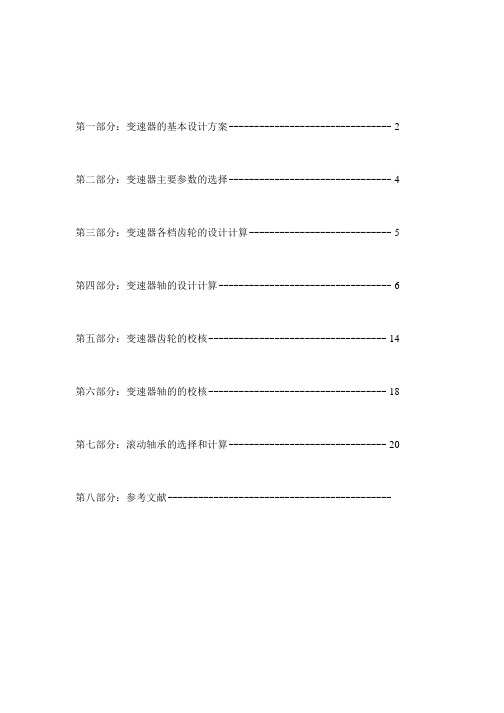
第一部分:变速器的基本设计方案-------------------------------- 2 第二部分:变速器主要参数的选择-------------------------------- 4 第三部分:变速器各档齿轮的设计计算---------------------------- 5 第四部分:变速器轴的设计计算---------------------------------- 6 第五部分:变速器齿轮的校核----------------------------------- 14 第六部分:变速器轴的的校核----------------------------------- 18 第七部分:滚动轴承的选择和计算------------------------------- 20 第八部分:参考文献--------------------------------------------第一部分变速器的基本设计方案变速器的结构对汽车的动力性、燃油经济性、换挡操纵的可靠性与轻便性,传动的平稳性与效率等都有直接的影响。
采用优化设计方法对变速器与主减速器,以及变速器的参数做优化匹配,可得到良好的动力性与燃油经济性;采用自锁及互锁装置、倒档安全装置,对接合齿采取倒锥齿侧(或越程接合、错位接合、齿厚减薄、台阶齿侧)等措施,以及其他结构措施,可使操纵可靠,不跳档、乱档、自行脱档和误挂倒档;采用同步器可使换挡轻便、无冲击及噪声;采用高齿、修形及参数优化等措施可使齿轮传动平稳、噪声低。
降低噪声水平已成为提高变速器质量和设计、工艺水平的关键。
变速器设计的基本要求:1)保证汽车有必要的动力性和经济性。
2)设置空挡,用来切断发动机的动力传输。
3)设置倒挡,使汽车能变速倒退行驶。
4)设置动力输出装置。
5)换挡迅速、省力、方便。
6)工作可靠。
变速器不得有跳挡、乱挡及换挡冲击等现象发生。
7)变速器应有高的工作效率。
绘制两轴式四档变速器传动简图,并分析一档和倒档传动路线
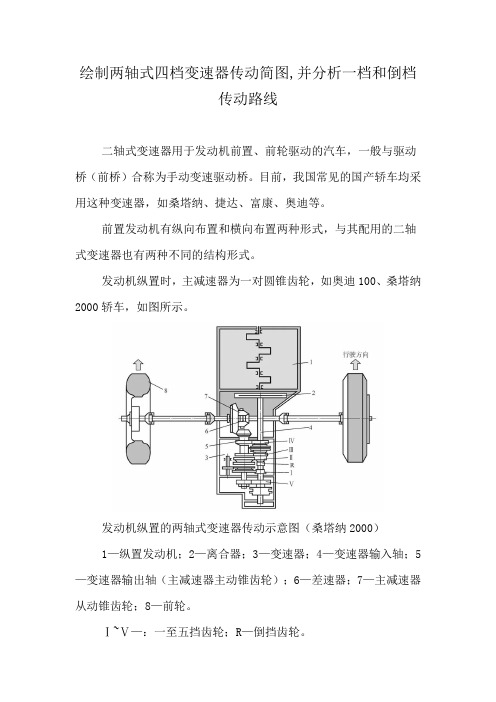
绘制两轴式四档变速器传动简图,并分析一档和倒档传动路线二轴式变速器用于发动机前置、前轮驱动的汽车,一般与驱动桥(前桥)合称为手动变速驱动桥。
目前,我国常见的国产轿车均采用这种变速器,如桑塔纳、捷达、富康、奥迪等。
前置发动机有纵向布置和横向布置两种形式,与其配用的二轴式变速器也有两种不同的结构形式。
发动机纵置时,主减速器为一对圆锥齿轮,如奥迪100、桑塔纳2000轿车,如图所示。
发动机纵置的两轴式变速器传动示意图(桑塔纳2000)1—纵置发动机;2—离合器;3—变速器;4—变速器输入轴;5—变速器输出轴(主减速器主动锥齿轮);6—差速器;7—主减速器从动锥齿轮;8—前轮。
Ⅰ~Ⅴ—:一至五挡齿轮;R—倒挡齿轮。
发动机横置时,主减速器采用一对圆柱齿轮,如下图所示。
发动机横置的两轴式变速器传动示意(捷达):一、发动机纵向布置二轴式手动变速器下面分别为桑塔纳2000型汽车二轴式五挡手动变速器传动机构的结构及示意图。
桑塔纳2000型汽车二轴式五挡手动变速器传动机构的结构:桑塔纳2000车型二轴式五挡手动变速器变速传动机构的示意图:该变速器的变速传动机构有输入轴和输出轴,二轴平行布置,输入轴是离合器的从动轴,输出轴是主减速器的主动锥齿轮轴。
该变速器具有五个前进挡(一至三挡为降速挡,四挡为直接挡,五挡为超速挡)和一个倒挡,全部采用锁环式惯性同步器换挡。
输入轴上有一至五挡主动齿轮,其中一挡、二挡主动齿轮与轴制成一体,三挡、四挡、五挡主动齿轮通过滚针轴承空套在轴上。
输入轴上还有倒挡主动齿轮,它与轴制成一体。
三挡、四挡同步器和五挡同步器也装在输入轴上。
输出轴上有一至五挡从动齿轮,其中一挡、二挡从动齿轮通过滚针轴承空套在轴上,三挡、四挡、五挡齿轮通过花键套装在轴上。
一挡、二挡同步器也装在输出轴上。
在变速器壳体的右端还装有倒挡轴,上面通过滚针轴承套装有倒挡中间齿轮。
桑塔纳2000车型变速器动力传动路线如下:一挡:变速器操纵杆从空挡向左、向前移动,实现动力→输入轴→输入轴→挡齿轮→输出轴→挡齿轮→输出轴上一挡、二挡同步器→输出轴→动力输出二挡:变速器操纵杆从空挡向左、向前移动,实现动力→输入轴→输入轴二挡齿轮→输出轴二挡齿轮→输出轴上一挡、二挡同步器→输出轴→动力输出三挡:变速器操纵杆从空挡向前移动,实现动力→输入轴→输入轴三挡、四挡同步器→输入轴三挡齿轮→输出轴三挡齿轮→输出轴→动力输出四挡:变速器操纵杆从空挡向后移动,实现动力→输入轴→输入轴三挡、四挡同步器→输入轴四挡齿轮→输出轴四挡齿轮→输出轴→动力输出五挡:变速器操纵杆从空挡向右、向前移动,实现动力→输入轴→输入轴五挡同步器→输入轴五挡齿轮→输出轴五挡齿轮→输出轴→动力输出倒挡:变速器操纵杆从空挡向右、向后移动,实现动力→输入轴→输出轴倒挡齿轮→倒挡轴倒挡齿轮→输出轴倒挡齿轮→输出轴→动力反向输出二、发动机横向布置二轴式手动变速器别克凯越汽车二轴式五挡变速器的结构:手动变速器(倒挡主动齿轮)动力传递示意:别克凯越汽车各挡动力传动路线如下:一挡:变速器操纵杆从空挡向左、向前移动,实现动力→主动轴→主动轴一挡齿轮→从动轴一挡齿轮→从动轴一挡、二挡同步器→从动轴→动力输出二挡:变速器操纵杆从空挡向左、向后移动,实现动力→主动轴→主动轴二挡齿轮→从动轴二挡齿轮→从动轴一挡、二挡同步器→从动轴→动力输出三挡:变速器操纵杆从空挡向前移动,实现动力→主动轴→主动轴三挡齿轮→从动轴三挡齿轮→从动轴三挡、四挡同步器→从动轴→动力输出四挡:变速器操纵杆从空挡向后移动,实现动力→主动轴→主动轴四挡齿轮→从动轴四挡齿轮→从动轴三挡、四挡同步器→从动轴→动力输出五挡:变速器操纵杆从空挡向右、向前移动,实现动力→主动轴→主动轴五挡齿轮→从动轴五挡齿轮→从动轴五挡同步器→从动轴→动力输出倒挡:变速器操纵杆从空挡向左、向前移动,实现动力→主动轴→主动轴倒挡齿轮→倒挡惰轮→倒挡从动齿轮(一挡、二挡同步器)→从动轴→动力反向输出。
捷达轿车gif两轴式变速器的设计本科毕业论文
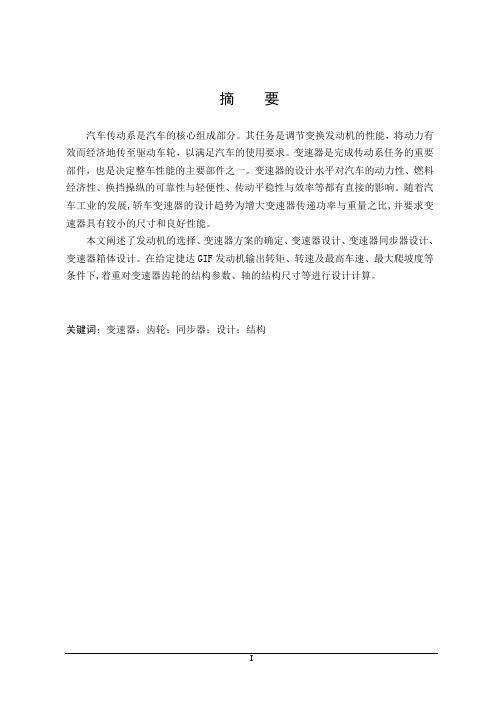
摘要汽车传动系是汽车的核心组成部分。
其任务是调节变换发动机的性能,将动力有效而经济地传至驱动车轮,以满足汽车的使用要求。
变速器是完成传动系任务的重要部件,也是决定整车性能的主要部件之一。
变速器的设计水平对汽车的动力性、燃料经济性、换挡操纵的可靠性与轻便性、传动平稳性与效率等都有直接的影响。
随着汽车工业的发展,轿车变速器的设计趋势为增大变速器传递功率与重量之比,并要求变速器具有较小的尺寸和良好性能。
本文阐述了发动机的选择、变速器方案的确定、变速器设计、变速器同步器设计、变速器箱体设计。
在给定捷达GIF发动机输出转矩、转速及最高车速、最大爬坡度等条件下,着重对变速器齿轮的结构参数、轴的结构尺寸等进行设计计算。
关键词:变速器;齿轮;同步器;设计;结构ABSTRACTDrivetrain is the core components of automobile. Its task is transforming and regulateing the performance of engine. Transmission can effectively and economically conveyed the power to the wheel which can meet the requirement of vehicles. Transmission is the important part of drivetrain components to complete the tasks. as well as one of the main factor to decide the whole performance of vehicle. The standards of Transmission designing can directly impact the vehicle dynamics, fuel economy, the reliability and portability of shifting, the smoothness and efficiency of Transmiting. Along with the development of the automobile industry, the trend of car transmission designing is to increase its transmission power and decrese its weight ,and hope have smaller size and excellent performance.This thesis are expounded the engine choice, transmission solution, transmission design , design for transmission the synchronizer, design for transmission the first axis ,design for transmission box.In conditions that knowing the JATTA engine out put torque, speed of engine and maximum speed of vehicles, maximum degree, focus on the designing of transmission gear structural parameters, axis geometry design computation; as well as the transmission and drive program structure design.Key words: Transmission;Gear;Synchronizer ;Design;Structure目录摘要 (I)Abstract (II)第1章绪论 (1)1.1 概述 (1)1.1.1 汽车变速器的设计要求 (1)1.1.2 国内外汽车变速器的发展现状 (2)1.2 设计的内容及方法 (4)第2章变速器传动机构与操纵机构的布置 (5)2.1 变速器传动机构布置方案 (5)2.1.1 变速器传动方案分析与选择 (5)2.1.2 倒档布置方案 (5)2.1.3 零部件结构方案分析 (6)2.2 变速器操纵机构布置方案 (8)2.2.1 概述 (8)2.2.2 典型的操纵机构及其锁定装置 (9)2.3 本章小结 (11)第3章变速器的设计与计算 (12)3.1 变速器主要参数的选择 (12)3.1.1 档数 (12)3.1.2 传动比范围 (12)3.1.3 变速器各档传动比的确定 (12)3.1.4 中心距的选择 (15)3.1.5 变速器的外形尺寸 (15)3.1.6 齿轮参数的选择 (15)3.1.7 各档齿轮齿数的分配及传动比的计算 (17)3.1.8 变速器齿轮的变位及齿轮螺旋角的调整....... 错误!未定义书签。
捷达变速器构造PPT(有彩图)
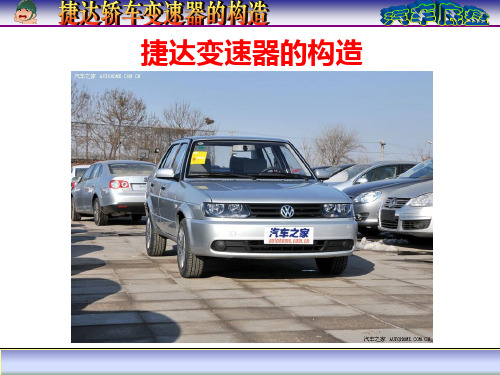
四档 齿轮
同步 器
(6)五档传动路线
五档 齿轮
同步 器
(7)倒档工作过程
倒档
轴
倒档 惰轮
一轴倒档齿轮 二轴倒档齿轮
• 对于发动机前置前轮驱动或发动机后置 • 后轮驱动的汽车,采用两轴式变速器。
驱动桥 变速器
捷达变速器变速器
离合 器
五前进档和一倒档
半轴
变速器壳 体
主减 速器
变速器一 轴
倒档轴 二轴ຫໍສະໝຸດ (2)一档传动路线一档 齿轮
(3)二档传动路线
二档 齿轮
(4)三档传动路线
同步器
三档 齿轮
(5)四档传动路线
捷达变速器的构造
捷达轿车变速器具有4/5个前进档和一个倒档,4/5个前进档全 带有同步器,取消了中间轴,只有输入轴和输出两根轴,充分利 用了变速器壳体,结构紧凑,所有前进档均为一对常啮合斜齿轮 传动,传动效率高,由于采用了全同步器,使换档迅速,操纵轻 便,同时减少了接合时的冲击和噪音,提高了变速器的使用寿命, 变速器中齿轮及轴承采用了飞溅润滑,使用GL4或G50号润滑油, 免维护,无需更换。
两轴式变速器的设计
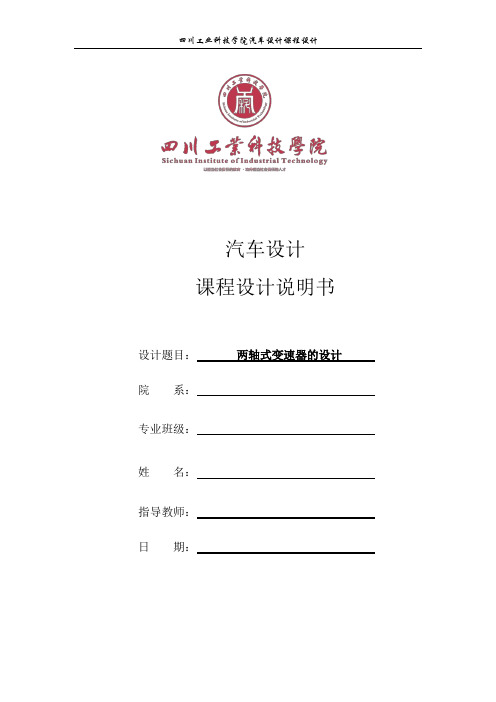
汽车设计课程设计说明书设计题目:两轴式变速器的设计院系:专业班级:姓名:指导教师:日期:目录一概述 (1)二变速器传动机构布置方案 (2)2.1传动机构布置方案分析 (2)2.1.1固定轴式变速器 (2)2.1.2倒挡布置方案 (2)2.1.3其他问题 (2)2.2零部件结构方案分析 (3)2.2.1齿轮形式 (3)2.2.2换挡机构形式 (3)三变速器主要参数的选择 (3)3.1档数 (3)3.2传动比范围 (3)3.3中心距 (4)3.4外形尺寸 (5)3.5齿轮参数 (5)3.6各档齿轮齿数的分配 (8)3.6.1确定一挡齿轮的齿数 (8)3.6.2对中心距A进行修正 (9)3.6.3确定常啮合传动齿轮副的齿数 (9)3.6.4确定其他各挡的齿数 (9)四变速器的设计与计算 (11)4.1齿轮的损坏形式 (11)4.2齿轮强度计算 (11)4.2.1齿轮弯曲强度的计算 (11)4.2.2轴的强度计算 (12)五同步器的设计 (13)5.1惯性式同步器 (13)5.2主要参数的确定 (13)5.2.1摩擦因数f (13)六变速器结构元件 (14)6.1变速器齿轮 (14)6.2变速器轴 (14)6.3变速器壳体 (15)七、总结 (15)一概述变速器用来改变发动机传到驱动轮上的转速和扭矩,目的是在原地起步、爬坡、转弯、加速等各种行驶工况下,使得汽车获得不同的牵引力和车速,同时使发动机在最有利的工况范围内工作。
变速器需要设置有空档,可在启动发动机、汽车滑行或者停车时中断发动机对驱动轮的动力传输。
同时,变速器也需要设置倒挡,能够使汽车获得倒退行驶的能力。
对变速器的基本要求:(1)保证汽车有良好的动力性和经济性。
(2)设置空档,使汽车有切断动力传输的能力。
(3)设置倒挡,使汽车有倒退行驶的能力。
(4)设置动力传输装置,需要时能进行功率输出。
(5)换挡迅速、省力、方便。
(6)工作可靠。
汽车在行驶过程中不得有跳档、乱档、以及换挡冲击的情形出现。
第08讲 两轴式变速器
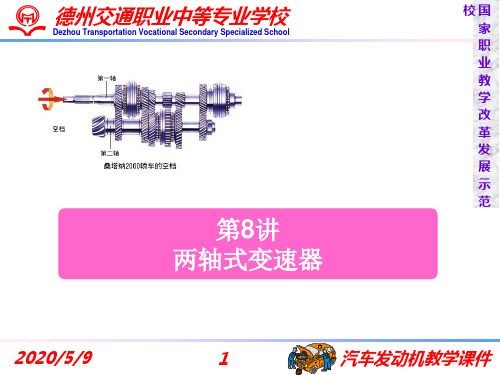
国 家 职 业 教 学 改 革 发 展 示 范 校
2015-3-31
6
汽车发动机教学课件
德州交通职业中等专业学校
Dezhou Transportation Vocational Secondary Specialized School
第08讲§两轴式变速器
三、两轴变速器的工作过程(视频)
国 家 职 业 教 学 改 革 发 展 示 范 校
德州交通职业中等专业学校
Dezhou Transportation Vocational Secondary Specialized School
分 标 题 二
国 家 职 业 教 学 改 革 发 展 示 范 校
第 8讲 两轴式变速器
2015-3-31
1
汽车发动机教学课件
德州交通职业中等专业学校
Dezhou Transportation Vocational Secondary Specialized School
德州交通职业中等专业学校dezhoutransportationvocationalsecondaryspecializedschool汽车发动机教学课件分标题二国家职业教学改革发展示范校20175101第8讲两轴式变速器讲两轴式变速器汽车发动机教学课件德州交通职业中等专业学校dezhoutransportationvocationalsecondaryspecializedschool国家职业教学改革发展示范校第08讲两轴式变速器20175102本讲主要知识点两轴式变速器的特点两轴式变速器的结构两轴式变速器的工作过程汽车发动机教学课件德州交通职业中等专业学校dezhoutransportationvocationalsecondaryspecializedschool国家职业教学改革发展示范校第08讲两轴式变速器20175103教学重点教学重点两轴式变速器的结构及特点两轴变速器各档位动力传动路线汽车发动机教学课件德州交通职业中等专业学校dezhoutransportationvocationalsecondaryspecializedschool国家职业教学改革发展示范校第08讲两轴式变速器201751041熟悉两轴式变速器的结构及特点两轴式变速器的结构及特点2掌握两轴式变速器的组成两轴式变速器的组成3掌握各档位动力传递路线各档位动力传递路线学习目标汽车发动机教学课件德州交通职业中等专业学校dezhoutransportationvocationalsecondaryspecializedschool国家职业教学改革发展示范校第08讲两轴式变速器20175105在ff或rr布置的汽车上广泛采用一般将主减速器和差速器也集成在变速箱内
捷达轿车变速器的设计
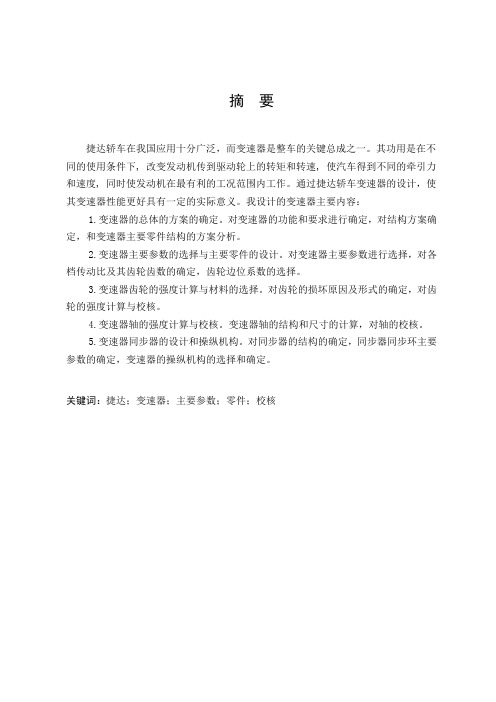
4.2.1齿轮弯曲强度计算…..............................................................................20
4.2.2齿轮接触应力…........................................................................................22
关键词:捷达;变速器;主要参数;零件;校核
ABSTRACT
The jetta cars used widely in our country, and the key is the vehicle transmission is one of the assembly. Its function is used in different conditions, changes to the drive wheels on the engine torque ancd rotational speed, make cars get different traction and the engine speed, and at the same time at the most favorable conditions range work. Through the jetta car transmission design, make its transmission better performance has certain practical significance. I designed the transmission main contents:
捷达两轴手动变速器设计

捷达两轴手动变速器设计摘要本设计的任务是设计一台10款捷达两轴手动变速器。
与中间轴式变速器比较,两轴式变速器有结构简单、轮廓尺寸小、布置方便、中间档位传动效率高和噪声低等优点。
根据轿车的外形、轮距、轴距、最小离地间隙、最小转弯半径、车辆重量、满载重量以及最高车速等参数结合自己选择的适合于该轿车的发动机型号可以得出发动机的最大功率、最大扭矩、排量等重要的参数。
再结合某些轿车的基本参数,选择适当的主减速比。
根据上述参数,再结合汽车设计、汽车理论、机械设计等相关知识,计算出相关的变速器参数并论证设计的合理性。
它功用是:①改变传动比,扩大驱动轮转矩和转速的变化范围,以适应经常变化的行驶条件,如起步、加速、上坡等,同时使发动机在有利的工况下工作;②在发动机旋转方向不变的前提下,使汽车能倒退行驶;③利用空档,中断动力传递,以使发动机能够起动、怠速,并便于发动机换档或进行动力输出。
这台变速器具有五个前进档(包括一个超速档五档)和一个倒档,并通过锁环式同步器来实现换档。
关键词:变速器,锁环式同步器,传动比,中间轴,第二轴,齿轮ABSTRACTThe duty of this design is to design a FR type manual transmission used in the saloon,It’s the countershaft-type transmission gearbox.Thistransmission has two prominent merits: Firstly,the transmission efficiency of the direct drive keeps off high, the attrition and the noise are also slightest;Secondly ,it’s allowed to obtain in the biger gear ratio of the first gear when the center distance is smaller.According to the contour,track,wheel base,the smallest ground clearance,the smallest turning radium,the vehicles weight, the all-up weight as well as the highest speed and so on, union the choosing engine model we can obtain the important parameters of the max power,the max torque, the displacement and so on. According to the basic parameters of the certain saloon,choose the suitable final drive ratio.According to the above parameters,combining the knowledge of automobile design, automobile theory, machine design and so on, calculate the correlated parameters of the gearbox and proof the rationality of the design.Its function is:①Changing gear ratio,expanding the torque of the driving wheel and the range of the rotational speed,to adapt the travel condition which frequently changes, like start, acceleration, climbing and so on, simultaneously causes the engine to work under the advantageous operating mode;②Under the premise of the invariable rotation, enables the automobile to travel back;③Using neutral, severances the power transmission, to make the engine start, idle, and is advantageous for the engine to shift gears or to carry on the dynamic output. This gearbox has five (including over drive—fifth gear) and a reverse gear, and through the inertial type of synchronizer to realize shift gears.KEY WORDS:transmission, inertial type of synchronizer,gear ratio,countershaft,second axis, gear毕业设计(论文)原创性声明和使用授权说明原创性声明本人郑重承诺:所呈交的毕业设计(论文),是我个人在指导教师的指导下进行的研究工作及取得的成果。
两轴式四档手动变速器设计
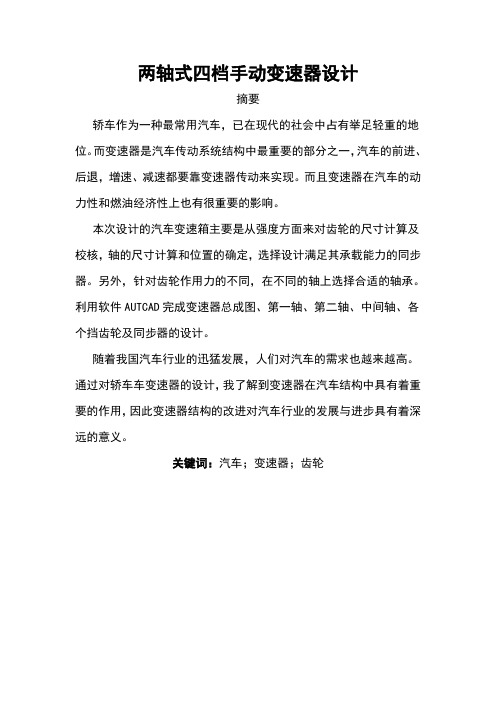
两轴式四档手动变速器设计摘要轿车作为一种最常用汽车,已在现代的社会中占有举足轻重的地位。
而变速器是汽车传动系统结构中最重要的部分之一,汽车的前进、后退,增速、减速都要靠变速器传动来实现。
而且变速器在汽车的动力性和燃油经济性上也有很重要的影响。
本次设计的汽车变速箱主要是从强度方面来对齿轮的尺寸计算及校核,轴的尺寸计算和位置的确定,选择设计满足其承载能力的同步器。
另外,针对齿轮作用力的不同,在不同的轴上选择合适的轴承。
利用软件AUTCAD完成变速器总成图、第一轴、第二轴、中间轴、各个挡齿轮及同步器的设计。
随着我国汽车行业的迅猛发展,人们对汽车的需求也越来越高。
通过对轿车车变速器的设计,我了解到变速器在汽车结构中具有着重要的作用,因此变速器结构的改进对汽车行业的发展与进步具有着深远的意义。
关键词:汽车;变速器;齿轮目录ABSTRACT第1章绪论 ---------------------------------------------1 1.1变速器的概述------------------------------------------11.2 变速器的种类 -------------------------------------------1 1.3机械式变速器的特点 ---------------------------------------4 第二章变速器传动机构布置方案-----------------------------52.1传动机构的布置方案分析 ---------------------------52.1.1固定轴式变速器-----------------------------------52.1.2倒档的布置方案--------------------------------------82.2变速器零、部件结构方案分析 ----------------------------9 2.2.1齿轮型式 ----------------------------------------92.2.2换档结构型式 ---------------------------------------92.2.3变速器轴承形式 -------------------------------102.2.4齿轮变位系数的选择原则 -------------------------112.2.5其他问题 ------------------------------------11第三章变速器主要参数选择 ----------------------------------12 3.1中心距A的选定 -----------------------------------123.2齿轮参数 -----------------------------------------123.2.1模数的选取 -------------------------------------123.2.2压力角α ----------------------------------------133.2.3螺旋角β ---------------------------------------143.2.4齿宽b ----------------------------------------143.3各档齿数的分配与计算 -------------------------------143.3.1一档齿轮齿数的确定---------------------------------143.3.2二档齿轮齿数的确定--------------------------------153.3.3三档齿轮齿数的确定--------------------------------153.3.4四档齿轮齿数的确定---------------------------------153.3.5倒档齿轮齿数的确定--------------------------------163.3.6各档齿轮参数表--------------------------------16第四章变速器的设计与计算 -------------------------------174.1齿轮的损坏形式 ---------------------------------174.2齿轮的强度计算 ---------------------------------174.3轴的强度计算 ---------------------------------------204.3.1初选轴的直径 ---------------------------------------21 4.3.2轴的强度验算 ------------------------------------214.3.3校核各挡齿轮处轴的强度和刚度 -------------------22第五章同步器的设计 ----------------------------------305.1惯性式同步器----------------------------------305.2锁环式同步器 -------------------------------------305.2.1锁环式同步器的结构 ---------------------------305.2.2锁环式同步器的工作原理 -----------------------315.3同步器重要参数的确定---------------------------------31第六章变速器的操纵机构 --------------------------------34参考文献 ------------------------------------------------35致谢 ------------------------------------------------------36第一章绪论1.1变速器的概述变速器作为传递力和改变汽车车速的主要装置,现在对其操纵的方便性和档位数方面的要求愈来愈高。
两轴式变速器
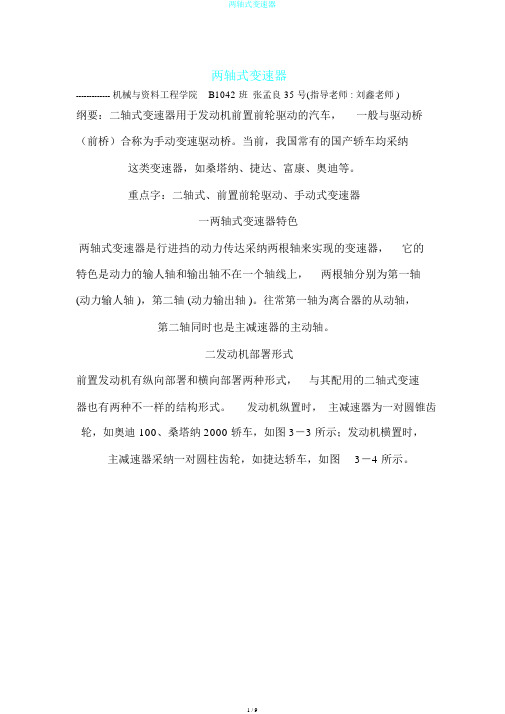
两轴式变速器------------- 机械与资料工程学院B1042 班张孟良 35 号(指导老师 : 刘鑫老师 )纲要:二轴式变速器用于发动机前置前轮驱动的汽车,一般与驱动桥(前桥)合称为手动变速驱动桥。
当前,我国常有的国产轿车均采纳这类变速器,如桑塔纳、捷达、富康、奥迪等。
重点字:二轴式、前置前轮驱动、手动式变速器一两轴式变速器特色两轴式变速器是行进挡的动力传达采纳两根轴来实现的变速器,它的特色是动力的输人轴和输出轴不在一个轴线上,两根轴分别为第一轴(动力输人轴 ),第二轴 (动力输出轴 )。
往常第一轴为离合器的从动轴,第二轴同时也是主减速器的主动轴。
二发动机部署形式前置发动机有纵向部署和横向部署两种形式,与其配用的二轴式变速器也有两种不一样的结构形式。
发动机纵置时,主减速器为一对圆锥齿轮,如奥迪 100、桑塔纳 2000 轿车,如图 3-3 所示;发动机横置时,主减速器采纳一对圆柱齿轮,如捷达轿车,如图3-4 所示。
图 3-3 发动机纵置的二轴式变速器传动表示图(桑塔纳 2000)1-纵置发动机 2-离合器 3-变速器 4-变速器输入轴 5-变速器输出轴(主减速器主动锥齿轮)6-差速器7-主减速器从动锥齿轮8-前轮Ⅰ、Ⅱ、Ⅲ、Ⅳ、Ⅴ-一、二、三、四、五档齿轮R-倒档齿轮图 3-4发动机横置的二轴式变速器传动表示图(捷达)1-发动机2-离合器3-变速器4-主减速器5-差速器6-带等角速万向节的半轴三发动机结构与工作过程1.发动机纵向部署的二轴式变速器如图 3-5、3-6 所示分别为桑塔纳2000 轿车二轴式变速器传动机构的结构图和表示图。
图 3-5桑塔纳2000轿车二轴式变速器传动机构的结构图1-四档齿轮2-三档齿轮3-二档齿轮4-倒档齿轮5-一档齿轮6-五档齿轮7-五档运转齿环8-换档机构壳体9-五档同步器10-齿轮箱体11-一、二档同步器12-变速器壳体13-三、四档同步器14-输出轴15-输入轴16—差速器图 3-6桑塔纳2000轿车二轴式变速器传动机构的表示图1-输入轴2-输出轴3-三、四档同步器4-一、二档同步器5-倒档中间齿轮Ⅰ-一档齿轮Ⅱ-二档齿轮Ⅲ-三档齿轮Ⅳ-四档齿轮Ⅴ-五档齿轮R-倒档齿轮1)结构该变速器的变速传动机构有输入轴和输出轴,二轴平行部署,输入轴也是离合器的从动轴,输出轴也是主减速器的主动锥齿轮轴。
(整理)捷达汽车变速器的设计 +1

变速器用来改变发动机传到驱动轮上的转矩和转速,是汽车总成部件中的重要组成部分,是主要的传动系统。
变速器的结构要求对汽车的动力性、燃料经济性、换档操纵的可靠性与轻便性、传动平稳性与效率等都有直接的影响。
本设计对变速器的各挡齿轮和轴以及轴承做了详细的设计计算,并进行了受力分析、强度和刚度校核计算,1.变速原理一对齿数不同的齿轮啮合传动时,设主动齿轮的转速为2n ,齿数为2z ,从动齿轮的转速为3n ,齿数为3z 。
若小齿轮带动大齿轮时,转速就降低了;若大齿轮带动小齿轮时,转速即升高。
在相同的时间内啮合的齿数相等,即2n 2z =3n 3z 。
齿轮的传动比为i =2n /3n =3z /2z 。
齿轮传动机构的传动比定义为主动齿轮的转速与从动齿轮的转速之比,它也等于从动齿轮的齿数与主动齿轮的齿数之比,即: 主动齿轮的齿数从动齿轮的齿数从动齿轮的转速主动齿轮的转速传动比==这就是齿轮传动的变速原理。
汽车变速器就是根据这一原理利用若干大小不同的齿轮副传动而实现变速的。
2.变向原理汽车发动机在工作过程中是不能逆转的。
为了能使汽车倒退行驶,在变速器中设置了倒挡(R )。
倒挡传动机构是在主动齿轮与从动齿轮之间增加一个中间齿轮,利用中间齿轮来改变输出轴的转动方向,因此,这个中间齿轮油称之为倒挡换挡齿轮]10[。
目录第2章变速器主要参数的选择与计算 (3)2.1设计初始数据 (3)2.2变速器各挡传动比的确定 (3)2.3变速器传动方案的确定 (5)2.4中心距A的确定 (6)2.5齿轮参数 (6)2.5.1 模数 (6)2.5.2 压力角α (7)2.5.3 螺旋角β (7)2.5.4 齿宽b (7)2.5.5 齿顶高系数 (8)2.6本章小结 (8)第3章齿轮的设计计算与校核 (9)3.1齿轮的设计与计算 (9)3.1.1 各挡齿轮齿数的分配 (9)3.1.2齿轮材料的选择原则 (18)3.1.3计算各轴的转矩 (19)3.2轮齿的校核 (19)3.2.1轮齿弯曲强度计算 (19)3.2.2轮齿接触应力σj (23)3.3本章小结 (28)第4章轴的设计与计算及轴承的选择与校核 (29)4.1轴的设计计算 (29)4.1.1 轴的工艺要求 (29)4.1.2 初选轴的直径 (29)4.1.3 轴的强度计算 (30)4.2轴承的选择及校核 (34)4.2.1输入轴的轴承选择与校核 (34)4.2.2 输出轴轴承校核 (35)4.3本章小结 (36)结论 (37)参考文献 (38)2章 变速器主要参数的选择与计算2.1设计初始数据最高车速:max a u =160Km/h 发动机功率:max e P =75KW 转矩:max e T =150m N * 总质量:a m =1500Kg 转矩转速:T n =3800r/min 车轮:185/60R142.2变速器各挡传动比的确定初选传动比: m a xa u = 0.3770min i i r n g p (2.1)式中: m a x a u —最高车速p n —发动机最大功率转速 r —车轮半径m i n g i —变速器最小传动比 乘用车取0.85 0i —主减速器传动比m a xe T =9549×pe n P max α (转矩适应系数α=1.1~1.3) (2.2) 所以,p n =9549×150742.1⨯=5653.006r/minp n / T n =1.4~2.0 符合0i =0.377×maxmin a g p u i rn =0.377×16085.010********⨯⨯⨯-=4.025 (2.3)双曲面主减速器,当0i ≤6时,取η=90% 最大传动比1g i 的选择]17[:①满足最大爬坡度。
(完整版)两轴式变速器
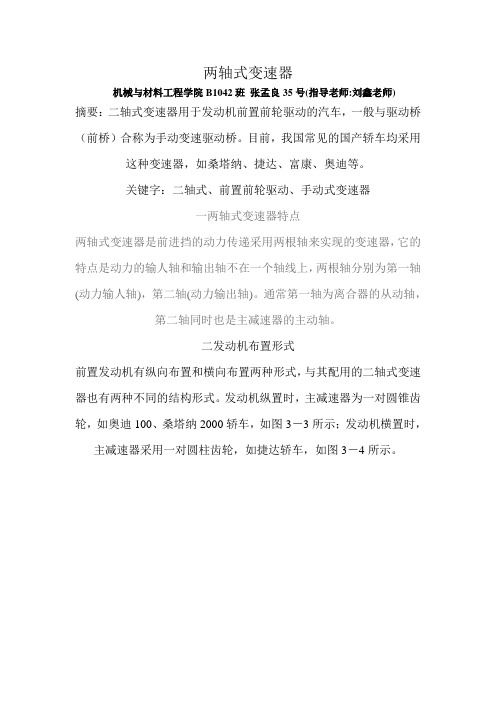
两轴式变速器-------------机械与材料工程学院B1042班张孟良35号(指导老师:刘鑫老师)摘要:二轴式变速器用于发动机前置前轮驱动的汽车,一般与驱动桥(前桥)合称为手动变速驱动桥。
目前,我国常见的国产轿车均采用这种变速器,如桑塔纳、捷达、富康、奥迪等。
关键字:二轴式、前置前轮驱动、手动式变速器一两轴式变速器特点两轴式变速器是前进挡的动力传递采用两根轴来实现的变速器,它的特点是动力的输人轴和输出轴不在一个轴线上,两根轴分别为第一轴(动力输人轴),第二轴(动力输出轴)。
通常第一轴为离合器的从动轴,第二轴同时也是主减速器的主动轴。
二发动机布置形式前置发动机有纵向布置和横向布置两种形式,与其配用的二轴式变速器也有两种不同的结构形式。
发动机纵置时,主减速器为一对圆锥齿轮,如奥迪100、桑塔纳2000轿车,如图3-3所示;发动机横置时,主减速器采用一对圆柱齿轮,如捷达轿车,如图3-4所示。
图3-3 发动机纵置的二轴式变速器传动示意图(桑塔纳2000)1-纵置发动机2-离合器3-变速器4-变速器输入轴5-变速器输出轴(主减速器主动锥齿轮)6-差速器7-主减速器从动锥齿轮8-前轮Ⅰ、Ⅱ、Ⅲ、Ⅳ、Ⅴ-一、二、三、四、五档齿轮R-倒档齿轮图3-4 发动机横置的二轴式变速器传动示意图(捷达)1-发动机2-离合器3-变速器4-主减速器5-差速器6-带等角速万向节的半轴三发动机结构与工作过程1.发动机纵向布置的二轴式变速器如图3-5、3-6所示分别为桑塔纳2000轿车二轴式变速器传动机构的结构图和示意图。
图3-5 桑塔纳2000轿车二轴式变速器传动机构的结构图1-四档齿轮2-三档齿轮3-二档齿轮4-倒档齿轮5-一档齿轮6-五档齿轮7-五档运行齿环8-换档机构壳体9-五档同步器10-齿轮箱体11-一、二档同步器12-变速器壳体13-三、四档同步器14-输出轴15-输入轴16—差速器图3-6 桑塔纳2000轿车二轴式变速器传动机构的示意图1-输入轴2-输出轴3-三、四档同步器4-一、二档同步器5-倒档中间齿轮Ⅰ-一档齿轮Ⅱ-二档齿轮Ⅲ-三档齿轮Ⅳ-四档齿轮Ⅴ-五档齿轮R-倒档齿轮1) 结构该变速器的变速传动机构有输入轴和输出轴,二轴平行布置,输入轴也是离合器的从动轴,输出轴也是主减速器的主动锥齿轮轴。
两轴式五挡手动变速器设计
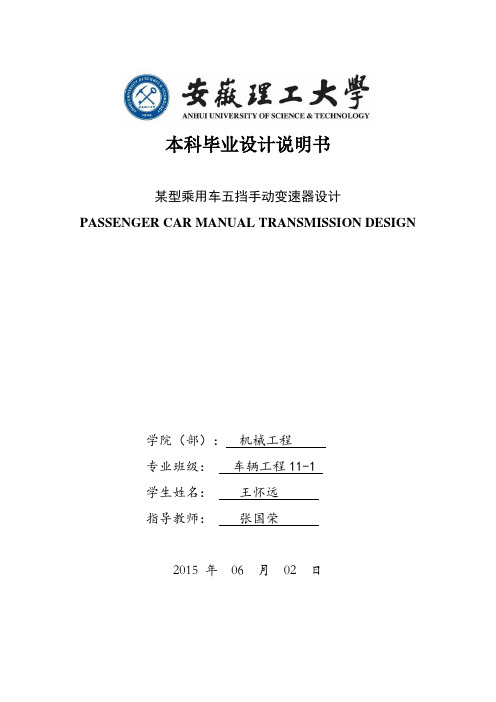
本科毕业设计说明书某型乘用车五挡手动变速器设计PASSENGER CAR MANUAL TRANSMISSION DESIGN学院(部):机械工程专业班级:车辆工程11-1学生姓名:***指导教师:***2015 年06 月02 日某型乘用车五挡手动变速器设计摘要本次设计针对小型前置前驱乘用车,综合考虑乘用车对乘坐舒适性、操作简便性、动力性以及燃油经济性等方面需求,进行五挡机械式变速器设计。
变速器结构采用两轴式,同时采用锁环式同步器换挡机构,使换挡更及时、更准确、更平稳。
设计过程包括动力参数分析、传动比分配、变速器结构设计以及各个零部件强度的校核。
在结构设计中,运用CATIA软件进行三维建模和结构分析,最后根据确定的参数完成工程图纸的绘制。
关键词:乘用车,机械式变速器,结构分析,强度校核PASSENGER CAR MANUAL TRANSMISSION DESIGNABSTRACTThe design is directed at small front precursor passenger cars. It takes various requirements into comprehensive consideration, such as comfort, ease operation, power performance and fuel economy.With two shaft type transmission structure, and using the lock ring synchronizer shifting mechanism at the same time, makes the shifting more timely, more accurate, more stable.Design process including analysis, dynamic parameters distribution of transmission ratio, the transmission structure design and strength check every parts and components.In structure design, using CATIA software for 3 d modeling and structure analysis, according to the determined parameters to complete drawing engineering drawings.KEYWORDS: passenger vehicles, mechanical transmission, structure analysis and strength check目录摘要 (I)ABSTRACT (II)1 机械式变速器设计概述.......................................................................................... 12 变速器传动机构布置方案.................................................................................... 32.1传动机构布置方案分析................................................................................. 32.2 零、部件结构方案分析................................................................................ 62.2.1 齿轮形式............................................................................................ 62.2.2换挡机构形式....................................................................................... 62.2.3 变速器轴承.......................................................................................... 73 变速器主要参数的选择.......................................................................................... 93.1 变速器挡数的确定和各挡传动比分配........................................................ 93.1.1确定最大和最小传动比[6] ................................................................... 93.1.2 确定中间各挡传动比...................................................................... 103.2中心距A ..................................................................................................... 113.3 齿轮参数.................................................................................................... 113.4 各挡齿轮齿数分配.................................................................................... 133.5 各挡齿轮参数计算.................................................................................... 153.5.1变位前齿轮参数见表3.5................................................................. 153.5.2 变位齿轮参数计算.......................................................................... 164 轮齿强度校核...................................................................................................... 214.1齿轮材料的选择原则[2] ............................................................................. 214.2各轴转矩计算............................................................................................. 234.3轮齿强度校核计算..................................................................................... 234.3.1轮齿弯曲应力计算与校核............................................................... 234.3.2轮齿接触应力j 计算与校核........................................................... 265 轴的结构设计及强度校核.................................................................................. 315.1轴的结构设计............................................................................................. 315.2轴的载荷计算及危险截面分析................................................................. 335.3轴的强度校核............................................................................................. 405.3.1轴的刚度校核................................................................................... 405.3.2轴的强度校核................................................................................... 446 同步器设计.......................................................................................................... 546.1锁环式同步器结构及其工作原理[1] ......................................................... 546.2锁环式同步器主要尺寸的确定................................................................. 556.3同步环主要参数确定................................................................................. 566.4同步器花键参数确定与计算..................................................................... 577 汽车环境保护...................................................................................................... 587.1我国环境保护的原则和政策..................................................................... 587.2汽车及内燃机污染与危害......................................................................... 587.2.1汽车及内燃机污染的主要表现....................................................... 587.2.2汽车及内燃机污染的危害............................................................... 587.3汽车与内燃机污染防治措施..................................................................... 59结论.......................................................................................................................... 60参考文献.................................................................................................................. 61附录A 乘用车五挡变速器装配效果图................................................................ 62附录B 锁环式同步器装配图................................................................................ 63谢辞.......................................................................................................................... 641 机械式变速器设计概述变速器通过不同传动比的切换使汽车能够很好地适应各种复杂工况。
捷达轿车GIF两轴式变速器的设计-开题报告
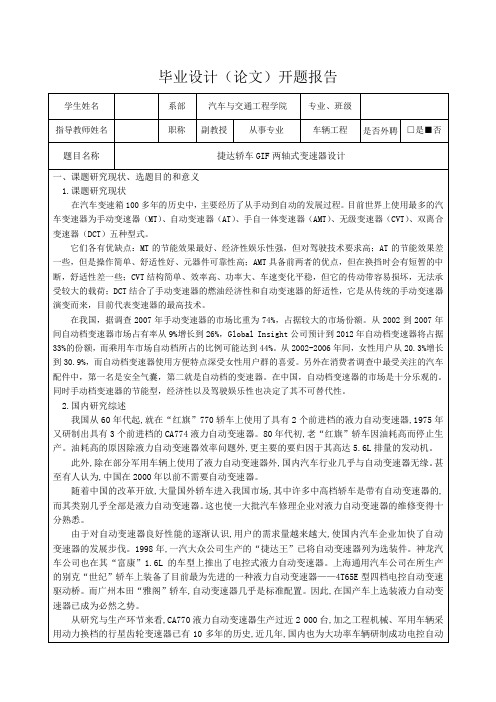
2.国内研究综述 我国从 60 年代起,就在“红旗”770 轿车上使用了具有 2 个前进档的液力自动变速器,1975 年
又研制出具有 3 个前进档的 CA774 液力自动变速器。80 年代初,老“红旗”轿车因油耗高而停止生 产。油耗高的原因除液力自动变速器效率问题外,更主要的要归因于其高达 5.6L 排量的发动机。
从研究与生产环节来看,CA770 液力自动变速器生产过近 2 000 台,加之工程机械、军用车辆采 用动力换档的行星齿轮变速器已有 10 多年的历史,近几年,国内也为大功率车辆研制成功电控自动
变速器,因此可以说,在液力自动变速器的研究、生产以及修理方面均有一定的基础。但目前国产轿 车所装用的液力自动变速器全部都依靠进口。不过通用汽车公司在上海的合资企业已开始试生产 4T65E 型四档电控自动变速驱动桥。当然,完全国产化还有一段路要走。
二、设计(论文)的基本内容、拟解决的主要问题 1.设计基本内容 (1)捷达轿车五档两轴式变速器传动机构布置方案 (2)捷达轿车变速器基本参数的确定 (3)捷达轿车各挡齿轮的设计及校核 (4)捷达轿车传动轴的设计及校核 (5)捷达轿车轴承的选择及校核 (6)捷达轿车同步器和操纵机构的设计选用 (7)捷达轿车变速器箱体的设计 (8)CAD 绘制装配图及零件图 2.拟解决的主要问题 (1)根据轿车的结构特点和行驶条件,拟定汽车的基本技术参数 (2)完成该车发动机的选择和传动系档数和各档传动比的确定 (3)完成汽车变速器总成设计,包括操纵机构、输入轴和输出轴
捷达五档手动变速器动力传递路线.

iR
z23 z19 z12 z2 z18 z17
42 22 43 19 13 21
7.66
3.2.2 发动机前置横向布置的两 轴式变速传动机构
学习目的与要求
1.掌握变速Βιβλιοθήκη 结构 2.熟悉各档动力传动路线3.能计算各档的传动比 图3-16 捷达王轿车五挡变速器结构图
倒档
5档
4档 3档 2档
z11 11
z12 40
z15 34
1档 z17 37
i1
z4 z6
38 11
3.455
i2
z18 z8
35 18
1.944
i3
z17 z9
37 27
1.370
捷达王轿车五挡变速器各 挡传动比依次为
i4
z16 z11
32 11
1.032
i5
z15 z12
3.2.1 三轴式变速传动机构
以东风EQ1092型汽车变速器为例介绍三轴式变速器结构
3.2.1.1 基本结构
图3-4 EQ1092型汽车五挡变速器变速传动示意图
3.2.1 三轴式变速传动机构
3.2.1.2 各挡传动路线及传动比
一挡传动比为 i1
z23 z12 z2 z18
42 43 7.31 19 13
1档
1、2档结 合套右移
1档
2档
1、2档结 合套左移
3、4档结 合套右移
3档
4档
3、4档结 合套左移
5档结合套 右移
5档
倒档中间 轴齿轮
轿车两轴四档变速器设计

[11] 王少怀.机械设计师手册[M].北京.电子工业出版社.2006.
[12] 殷玉枫.机械设计课程设计[M].北京.机械工业出版社.2006.
[13] 于志生.汽车理论[M].北京.机械工业出版社.2000.
[14] 向立明.汽车变速器的发展历史和未来趋势[M].公路与运输.2007.
[15] 杨可桢 程光蕴 李仲生.机械设计基础[M].北京.高等教育出版社.2006.
总体来看,今年我国自主乘用车变速器企业发展势头良好,受惠于国家节能减排政策影响,小排量乘用车销量的提升带动变速器配套数量增长,今年小排量车用变速器表现突出。
我国明年乘用车市场上,由于自主品牌变速器在小排量紧凑型乘用车市场地位稳固,国产变速器预期可能会有12%~15%的增长。随着一线城市汽车数量逐渐饱和,乘用车市场自然会向二、三线城市转移。二、三线城市消费者由于购买力相对有限,第一次购车大多选择性价比较高的自主品牌车和小排量车,这无论对自主品牌乘用车还是自主品牌乘用车变速器企业都是机遇。
[16] 成大先.机械设计手册[M].北京.化学工业出版社.2004.
[17] 王宝玺 贾庆祥.汽车制造工艺学[M].北京.机械工业出版社.2007.
[18] 王大全.汽车常用数据手册[M].北京.化学工业出版社.2006.
[19] Amir Ibrahim,A,Qin Dation,LiuZhengjun,Acontrol strategy on starting up of vehicle with automatic manual transmission (AMT) [J],Information technology,2005,4 (2) :140-145
- 1、下载文档前请自行甄别文档内容的完整性,平台不提供额外的编辑、内容补充、找答案等附加服务。
- 2、"仅部分预览"的文档,不可在线预览部分如存在完整性等问题,可反馈申请退款(可完整预览的文档不适用该条件!)。
- 3、如文档侵犯您的权益,请联系客服反馈,我们会尽快为您处理(人工客服工作时间:9:00-18:30)。
摘要汽车传动系是汽车的核心组成部分。
其任务是调节变换发动机的性能,将动力有效而经济地传至驱动车轮,以满足汽车的使用要求。
变速器是完成传动系任务的重要部件,也是决定整车性能的主要部件之一。
变速器的设计水平对汽车的动力性、燃料经济性、换挡操纵的可靠性与轻便性、传动平稳性与效率等都有直接的影响。
随着汽车工业的发展,轿车变速器的设计趋势为增大变速器传递功率与重量之比,并要求变速器具有较小的尺寸和良好性能。
本文阐述了发动机的选择、变速器方案的确定、变速器设计、变速器同步器设计、变速器箱体设计。
在给定捷达GIF发动机输出转矩、转速及最高车速、最大爬坡度等条件下,着重对变速器齿轮的结构参数、轴的结构尺寸等进行设计计算。
关键词:变速器;齿轮;同步器;设计;结构ABSTRACTDrivetrain is the core components of automobile. Its task is transforming and regulateing the performance of engine. Transmission can effectively and economically conveyed the power to the wheel which can meet the requirement of vehicles. Transmission is the important part of drivetrain components to complete the tasks. as well as one of the main factor to decide the whole performance of vehicle. The standards of Transmission designing can directly impact the vehicle dynamics, fuel economy, the reliability and portability of shifting, the smoothness and efficiency of Transmiting. Along with the development of the automobile industry, the trend of car transmission designing is to increase its transmission power and decrese its weight ,and hope have smaller size and excellent performance.This thesis are expounded the engine choice, transmission solution, transmission design , design for transmission the synchronizer, design for transmission the first axis ,design for transmission box.In conditions that knowing the JATTA engine out put torque, speed of engine and maximum speed of vehicles, maximum degree, focus on the designing of transmission gear structural parameters, axis geometry design computation; as well as the transmission and drive program structure design.Key words: Transmission;Gear;Synchronizer ;Design;Structure目录摘要 (I)Abstract (II)第1章绪论 (1)1.1 概述 (1)1.1.1 汽车变速器的设计要求 (1)1.1.2 国内外汽车变速器的发展现状 (2)1.2 设计的内容及方法 (4)第2章变速器传动机构与操纵机构的布置 (5)2.1 变速器传动机构布置方案 (5)2.1.1 变速器传动方案分析与选择 (5)2.1.2 倒档布置方案 (5)2.1.3 零部件结构方案分析 (6)2.2 变速器操纵机构布置方案 (8)2.2.1 概述 (8)2.2.2 典型的操纵机构及其锁定装置 (9)2.3 本章小结 (11)第3章变速器的设计与计算 (12)3.1 变速器主要参数的选择 (12)3.1.1 档数 (12)3.1.2 传动比范围 (12)3.1.3 变速器各档传动比的确定 (12)3.1.4 中心距的选择 (15)3.1.5 变速器的外形尺寸 (15)3.1.6 齿轮参数的选择 (15)3.1.7 各档齿轮齿数的分配及传动比的计算 (17)3.1.8 变速器齿轮的变位及齿轮螺旋角的调整 (20)3.2 变速器齿轮强度校核 (21)3.2.1 齿轮材料的选择原则 (21)3.2.2 变速器齿轮弯曲强度校核 (22)3.2.3 轮齿接触应力校核 (25)3.2.4 倒档齿轮的校核 (29)3.3 轴的结构和尺寸设计 (32)3.3.1 初选轴的直径 (32)3.4 轴的强度验算 (34)3.4.1 轴的刚度计算 (34)3.4.2 轴的强度计算 (41)3.5 轴承选择与寿命计算 (46)3.5.1 输入轴轴承的选择与寿命计算 (47)3.5.2 输出轴轴承的选择与寿命计算 (49)3.6 本章小结 (51)第4章变速器同步器及结构元件设计 (52)4.1 同步器设计 (52)4.1.1 同步器的功用及分类 (52)4.1.2 惯性式同步器 (52)4.1.3 锁环式同步器主要尺寸的确定 (53)4.1.4 主要参数的确定 (54)4.2 变速器壳体 (56)4.3 本章小结 (56)结论 (57)参考文献 (58)致谢 (59)附录 (60)第1章绪论1.1 概述随着汽车工业的迅猛发展,车型的多样化、个性化已经成为汽车发展的趋势。
而变速器设计是汽车设计中重要的环节之一。
它是用来改变发动机传到驱动轮上的转矩和转速,目的是在各种行驶工况下,使汽车获得不同的牵引力和速度,同时使发动机在最有利的工况范围内工作。
因此它的性能影响到汽车的动力性和经济性指标,对轿车而言,其设计意义更为明显。
在对汽车性能要求越来越高的今天,车辆的舒适性也是评价汽车的一个重要指标,而变速器的设计不合理,将会使汽车的舒适性下降,使汽车的运行噪声增大,影响汽车的整体性。
1.1.1 汽车变速器的设计要求汽车传动系是汽车的核心组成部分。
其任务是调节、变换发动机的性能,将动力有效而经济地传至驱动车轮,以满足汽车的使用要求[1]。
变速器是完成传动系任务的重要部件,也是决定整车性能的主要部件之一。
变速器的结构要求对汽车的动力性、燃料经济性、换档操纵的可靠性与轻便性、传动平稳性与效率等都有直接的影响。
随着汽车工业的发展,轿车变速器的设计趋势是增大其传递功率与重量之比,并要求其具有更小的尺寸和良好的性能。
在汽车变速器的设计工作开始之前,首先要根据变速器运用的实际场合来对一些主要参数做出选择。
主要参数包括中心距、变速器轴向尺寸、轴的直径、齿轮参数、各档齿轮的齿数等。
变速器的基本设计要求[2]:保证汽车有必要的动力性和经济性;设置空档,用来切断发动机动力向驱动轮的传输;设置倒档,使汽车能倒退行驶;换档迅速、省力、方便;工作可靠,汽车行驶过程中,变速器不得有跳档、乱档,以及换档冲击等现象出现;工作效率高,噪声小;结构简单、方案合理;在满载及冲击载荷条件下,使用寿命长;除此之外,变速器还应当满足轮廓尺寸和质量小、制造成本低、维修方便等要求。
变速器传动机构有两种分类方法。
根据前进档数分为:三档变速器,四档变速器,五档变速器,多档变速器。
根据轴的形式分为:固定轴式,旋转轴式。
其中固定轴式又分为:两轴式变速器,中间轴式变速器,双中间轴式变速器,多中间轴式变速器。
固定轴式应用广泛,其中两轴式变速器多用于发动机前置前轮驱动的汽车上,中间轴式变速器多用于发动机前置后轮驱动的汽车上。
旋转轴式主要用于液力机械式变速器。
1.1.2 国内外汽车变速器的发展现状汽车自动变速器目前在国际上已成为发展趋势。
与传统的手动变速器相比,汽车自动变速器在节能、可操控和驾驶舒适性等方面有显著优势。
因此,自动变速器在汽车工业发达国家和地区的市场占有率越来越高。
当前,自动变速器在美国汽车市场上的占有率接近90%,在日本汽车市场上占有率在80%以上,在欧洲乘用车市场上占有率在50%以上,而在我国目前6000多万辆的汽车保有量中,自动挡车约占10%以上。
在美国,AT(液力自动变速器)占有绝对优势。
这主要是因为其自动变速器发展较早,消费者要求汽车必须操控简单,驾乘舒适,且对油耗并不敏感。
这种消费习惯造就了美国以AT为主的自动变速器市场。
欧洲消费者注重驾驶体验和驾驶乐趣,喜欢手动操控对机械带来的控制感,并且对油耗比较看重,所以自动变速器发展空间T(双离合器式自动变速器)出现后,立刻成为欧洲市场的宠儿。
日本是世界上CVT(无级变速器)装车率最高的市场。
日本消费者对CVT这种可以使发动机一直工作在同一转速区间保持低噪声并连续加速的变速器青睐有加。
在我国,自动变速器市场近些年每年都在以20%的速度增长,但毕竟起步晚,基础薄弱,大量自动变速器仍然依赖进口。
自主品牌企业开发了一些新产品,但多数没有形成产业化,产品技术路线也不是十分清晰。
本刊将从第10期开始连续在“产业透视”栏目介绍我国自动变速器发展现状及未来趋势,以飨读者。
变速器是汽车能量的“转换器”,其性能好坏对现代汽车行驶的平顺性、舒适性、连贯性等至关重要。
随着国内外汽车市场的发展,采用自动变速器的自动挡车需求量加大,近两年我国轿车市场中自动挡车型的销量约占总销量的35%左右。
但由于自动变速器结构复杂,研发成本高,零件加工难度大,研制技术及生产被国外企业所垄断,国内市场这类产品生产能力很小,主要由外资及外资控股企业生产,其余基本依靠进口。
我国从60年代起,就在“红旗”770轿车上使用了具有2个前进档的液力自动变速器,1975年又研制出具有3个前进档的CA774液力自动变速器。
80年代初,老“红旗”轿车因油耗高而停止生产。
油耗高的原因除液力自动变速器效率问题外,更主要的要归因于其高达5.6L排量的发动机。
